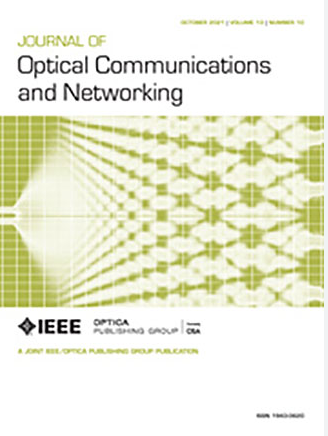基于传输质量的光线路控制局部和全局优化方法
IF 4
2区 计算机科学
Q1 COMPUTER SCIENCE, HARDWARE & ARCHITECTURE
引用次数: 0
摘要
近几十年来,数据流量需求不断增长,促使网络运营商重视基础设施控制,以促进其可扩展性并最大限度地提高其容量。通用光路(LP)的部署是从网络中一对给定节点之间的流量请求开始的。LP 在网络中的运行基于对传输质量(QoT)的估计,而传输质量是根据所选路由的物理层特性得出的。无论使用何种模型来估计 QoT,都有必要对模型进行校准,以最大限度地提高其准确性,并确定最小设计余量。模型校准过程在很大程度上取决于可在现场收集的数据类型(即度量类型、分辨率),因此也取决于可用的监测设备。在这项工作中,我们对多跨度掺铒光纤放大光线路系统(OLS)的 QoT 估算进行了系统评估,在第一种情况下仅使用总功率监测器,在第二种情况下使用实验模拟光通道监测器(OCM)。根据现有监测设备的类型,校准了三种不同的物理模型,并使用六种优化方法来确定光放大器目标增益和倾斜参数的最佳配置,共同优化所有放大器的工作点(全局方法)或逐个跨度进行优化(局部方法)。随后,在获得的每个配置中设置 OLS,最后测量广义信噪比(GSNR)曲线。本文章由计算机程序翻译,如有差异,请以英文原文为准。
Local and global optimization methods for optical line control based on quality of transmission
The ever-increasing demand for data traffic in recent decades has pushed network operators to give importance to the aspect of infrastructure control to facilitate its scalability and maximize its capacity. A generic lightpath (LP) is deployed starting from a traffic request between a given pair of nodes in a network. LPs are operated in the network based on an estimate of the quality of transmission (QoT), which is derived from the physical layer characteristics of a selected route. Regardless of the model used to estimate QoT, it is necessary to calibrate the model to maximize its accuracy and define minimum design margins. The model calibration process depends significantly on the type of data that can be collected in the field (i.e., type of metric, resolution) and therefore on the available monitoring devices. In this work, a systematic evaluation of the QoT estimation is carried out on a multi-span erbium-doped-fiber-amplified optical line system (OLS) using in the first case only total power monitors and in the second experimentally emulating optical channel monitors (OCMs). Given the type of monitoring devices available, three different physical models are calibrated, and six optimization methods are used to define the optimal configuration of the target gain and tilt parameters of the optical amplifiers, jointly optimizing the working point of all amplifiers (global approach) or proceeding span by span (local approach). Subsequently, the OLS was set in each configuration obtained, and the generalized signal-to-noise ratio (GSNR) profile was measured at the end.
求助全文
通过发布文献求助,成功后即可免费获取论文全文。
去求助
来源期刊
CiteScore
9.40
自引率
16.00%
发文量
104
审稿时长
4 months
期刊介绍:
The scope of the Journal includes advances in the state-of-the-art of optical networking science, technology, and engineering. Both theoretical contributions (including new techniques, concepts, analyses, and economic studies) and practical contributions (including optical networking experiments, prototypes, and new applications) are encouraged. Subareas of interest include the architecture and design of optical networks, optical network survivability and security, software-defined optical networking, elastic optical networks, data and control plane advances, network management related innovation, and optical access networks. Enabling technologies and their applications are suitable topics only if the results are shown to directly impact optical networking beyond simple point-to-point networks.

 求助内容:
求助内容: 应助结果提醒方式:
应助结果提醒方式:


